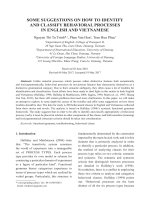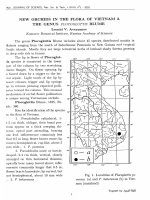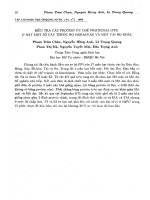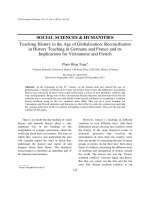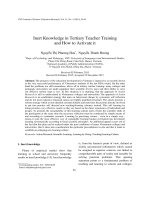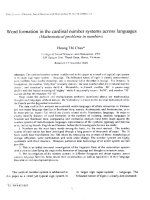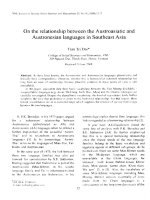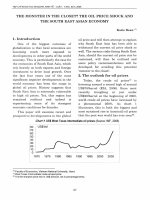DSpace at VNU: Taiwanese Investment in Vietnam: Current Development and Issues
Bạn đang xem bản rút gọn của tài liệu. Xem và tải ngay bản đầy đủ của tài liệu tại đây (294.01 KB, 10 trang )
VNU Journal of Science, Vol. 32, No. 1S (2016) 218-227
Taiwanese Investment in Vietnam:
Current Development and Issues
Nguyen Hong Son*, Nguyen Thi Minh Phuong
University of Economics and Business, VNU, 144 Xuan Thuy, Cau Giay, Hanoi, Vietnam
Received 06 October 2016
Revised 18 October 2016; Accepted 28 November 2016
Abstract: Taiwan is the 4th largest foreign investor in Vietnam. Taiwanese FDI on the one hand
has contributed to Vietnam’s economic development, on the other hand has raised some serious
issues related to the country’s sustainable development. In order to analyze the current
development and emerging issues related to Taiwanese investment in Vietnam, this paper focused
on the following contents: (i) Characteristics of Taiwanese FDI inflows in comparison with the
FDI flows into Vietnam in general; (ii) Some issues arising during the operation of Taiwanese FDI
enterprises in Vietnam and those arising in the context of Vietnam’s international economic
integration and economic restructuring; (iii) Opportunities to attract high-quality FDI from Taiwan
towards sustainable development and some policy implications for Vietnam. The results show that
FDI flows from Taiwan have increased significantly, especially since Vietnam joined the WTO.
Taiwanese outward FDI into Vietnam focused mostly on labor-intensive sectors such as
manufacturing of metals, chemicals and textiles. Taiwanese FDI contributed 2.2-2.3% of
Vietnam’s total social investment; created 1.2 million jobs and helped improve the industrial
structure. However, Taiwanese FDI is also characterized by low and medium level technology;
sharp increase in “dirty industries” classified by Mani and Wheeler (1997) and social problems
related to local labor. In the context of Vietnam’s shift to encourage development of high value
added manufacturing and services sectors and the country’s direction of sustainable development,
IT, electronic products as well as education and training may be the most promising sectors for
Taiwanese investment in Vietnam in the future.
Keywords: Foreign Direct Investment, Taiwan, Vietnam
1. Introduction*
the group of lower middle-income country
since 2010 and its GDP per capita reached
about USD 2,100 by the end of 2015. Vietnam
has also achieved most and in some cases
surpassed a number of the Millennium
Development Goals, particularly with the goals
of poverty reduction1.
Since political and economic reforms (“Doi
Moi”) launched in 1986, Vietnam has gained
remarkable economic development. Vietnam’s
average growth rate is 6.4% a year from 2000
until now. From being one of the poorest
countries in the world with GDP per capita
below USD 100 in 1990, Vietnam has joined
_______
_______
*
1
/>last updated on 26th September, 2016.
Corresponding author. Tel.: 84-912257733
Email:
218
218
N.H. Son, N.T.M. Phuong / VNU Journal of Science, Vol. 32, No. 1S (2016) 218-227
To obtain such achievements, resources for
development have been raised from many
channels, among which foreign direct
investment (FDI) is a very important one.
Thanks to the country’s process of economic
integration, beginning with the promulgation of
the Law on Investment in 1987, annual FDI
inflows increased dramatically from USD 0.32
billion in 1988 to USD 14.5 billion of realized
FDI in 2015 (Statistics of General Statistics
Office 2016).
Among 110 countries and territories
investing in Vietnam, Taiwan is one of the first
comers and by the end of 2015 Taiwan ranked
the 4th largest investors in Vietnam with 2478
still-valid projects and cumulative FDI inflows
of nearly USD 31 billion, accounting for 11%
of the total FDI inflows into Vietnam (Statistics
of Vietnam’s Ministry of Planning and
Investment – MPI 2016). FDI inflows from
Taiwan have contributed to Vietnam’s
economic growth, not only through providing
investment capital but also stimulating export
activities, creating jobs, transferring technology
and generating other spill-over effects.
However, besides positive impacts, FDI from
Taiwan is still a controversial topic because of
its negative impacts related to environmental
and social issues in Vietnam recently.
In the current context of Vietnam’s active
participation in the international and regional
economic integration (e.g. joining EU –
Vietnam Free Trade Agreement - EVFTA,
Trans Pacific Partnership - TPP, ASEAN
Economic Community – AEC, etc.) and the
country’s process of restructuring, it is
necessary to identify the opportunities for
attracting more FDI of high quality from
Taiwan towards sustainable development in
Vietnam. For that purpose, this paper focuses
on three main contents: (i) The current
development of Taiwanese FDI in Vietnam; (ii)
Emerging issues related to Taiwanese FDI in
Vietnam and (iii) Conclusion and some
implications.
219
2. The current development of Taiwanese
FDI in Vietnam
Right after the promulgation of the Law on
Foreign Investment in 1987, Taiwan’s
companies were among the earliest foreign
investors in Vietnam. Since then Vietnam’s FDI
inflows from Taiwan has developed rapidly. By
the end of 2015, Taiwan is the 4th largest
investor in Vietnam in terms of accumulated
registered capital. During the period of 19912015, the total registered investment capital of
Taiwan reached nearly USD 31 billion,
accounting for 11% of the total registered FDI
inflows into Vietnam. In terms of the number of
projects, Taiwan ranks the 3rd with a total of
2478 projects. In terms of the average scale of
FDI projects, Taiwanese projects are relatively
small (USD 12.51 million) in comparison with
those of other countries and territories (the
average value of all FDI projects is USD 14.04
million) (Table 2.1).
During 1991-2015, the registered FDI from
Taiwan into Vietnam increased 86 times, from
only USD 17 million in 1991 up to USD 1468
million in 2015. In 1993, Taiwanese approved
outward FDI to Vietnam surged to USD 158
million, resulting from the signing of
Agreement on promotion and protection of
investments between Vietnam Economic and
Cultural Office in Taipei and Taipei Economic
and Cultural Office in Hanoi in the same year.
However, a decline in Vietnam’s FDI inflows
from Taiwan was witnessed during 1994-2002
mainly due to the Asian financial crisis in 1997;
except for the year of 1998 when the two
partners signed the Agreement on avoidance of
double taxation. The trend during 2003-2007
was relatively stable with around USD 95-160
million of total registered FDI per year. In
2008, Taiwanese FDI inflows into Vietnam
boomed to USD 639 million as a result of
Vietnam’s becoming a member of WTO in
2007 as well as Taiwan’s “Southward Strategy”
to diversify Taiwan’s outward FDI toward
Southeast Asia. Since then, though being
affected by the global economic downturn, the
N.H. Son, N.T.M. Phuong / VNU Journal of Science, Vol. 32, No. 1S (2016) 218-227
220
registered FDI from Taiwan into Vietnam has
generally followed a steep upward trend,
reaching nearly USD 1.5 billion and accounting
for 9% of Vietnam’s total FDI inflows in 2015
(Figure 2.1).
Table 2.1. Top 10 of countries and territories having FDI in Vietnam, accumulated by 31st December 2015
Rank
1
2
3
4
5
6
7
8
9
10
Investors
Number of
Projects
South Korea
Japan
Singapore
Taiwan
British Virgin Islands
Hong Kong
Malaysia
The United States
China
Netherlands
Others
Total
4970
2914
1544
2478
623
975
523
781
1296
255
3710
20069
Registered
investment capital
(Million USD)
45191.10
38973.63
35148.51
30997.43
19275.31
15546.76
13420.05
11301.82
10174.22
8264.55
53589.09
281882.47
Share of total
registered investment
capital (%)
16.0
13.8
12.5
11.0
6.8
5.5
4.8
4.0
3.6
2.9
19.1
100.0
Average value
per project
(Million USD)
9.09
13.37
22.76
12.51
30.94
15.95
25.66
14.47
7.85
32.41
14.44
14.04
Source: Statistics of Vietnam MPI Foreign Investment Agency, 2016.
Figure 2.1. Taiwanese FDI inflows in Vietnam, 1991-2015 (Million USD).
Source: Authors’ calculation from [1].
Regarding to the field of investment, as of
2013 nearly 90% of Taiwanese OFDI into
Vietnam poured into manufacturing sector,
followed by Financial and insurance services,
Wholesale and retail trade, and Construction
with 6.67%, 1.8% and 0.56% respectively
(Figure 2.2.a). Other sectors account for a very
small portion, less than 0.5% for each. In
manufacturing sector, manufacturing of basic
metal, chemical materials, textile mills, nonmetallic and mineral products, fabricated metal
products were among subsectors that attracted
the most FDI flows from Taiwan, with 29.9%,
13.8%, 12.7%, 11% and 7% respectively
(Figure 2.2.b).
N.H. Son, N.T.M. Phuong / VNU Journal of Science, Vol. 32, No. 1S (2016) 218-227
221
Figure 2.2. Taiwanese FDI in Vietnam by sector and sub-sector as of 2013 (%).
Source: Authors’ calculation from [2].
It can be seen that most of Taiwanese FDI
manufacturing projects in Vietnam concentrates
on labor-intensive and environmental-sensitive
subsectors. By the end of 2013, electronic parts
and components manufacturing contributed to
only 4.1% of the total Taiwanese OFDI into
Vietnam meanwhile this is the largest subsector
that Taiwan invested overseas, contributing to
37.6% of the total Taiwanese OFDI in 2015 [1].
Taiwan seems to have a significant shift in
its OFDI towards Southeast Asia in general and
Vietnam in particular. Not considering
Mainland China (receiving nearly 2/3 of the
total Taiwanese OFDI), the share of Taiwanese
OFDI into Vietnam increased dramatically from
2.8% during 1991-2007 to 14.5% during 20082015 [1]. Vietnam even accounted for 33% of
Taiwan’s world total OFDI flows in 2013 [2].
This is attributed to some following factors.
First, Taiwan’s industrialization strategy
focusing on high-tech industries and tends to
shift the labor-intensive production to
developing economies, especially to Southeast
Asia countries. According to Vietnam MPI
Foreign Investment Agency, Taiwan’s investors
chose Vietnam as investment destination
because of (i) low labor costs, (ii) low land rent,
tariff preferences and other incentives and (iii)
exploitation of market potential2.
_______
2
accessed on 15th August 2016.
Second, Vietnam’s economic integration
also promotes Taiwanese investment in order to
make use of the advantages (tariff removal,
trade facilitation, etc.) that Vietnam being
awarded by other members joining in the same
FTA. This can explain the surge of FDI inflows
from Taiwan into Vietnam since 2008. The fact
that Vietnam has signed or concluded
negotiations of many important FTAs (EVFTA,
TPP, AEC, etc.) therefore leads to expectation
of a continuing increase in Vietnam’s FDI
inflows from Taiwan in the future.
Third, to comply with international and
regional commitments that Vietnam has made,
the country reviewed, promulgated or amended
legal documents towards a freer and fairer
investment regime. In specific, Vietnam
promulgated the Law on Investment in 20053,
remarking the first time Vietnam had a common
Law on Investment applied to both domestic
and foreign investors (replacing the Law on
Foreign Investment in 1987, revised in 1990,
1992, 1996, 2000 and the Law on Promotion of
Domestic Investment in 1998). More recently,
the Law on Investment in 20144 was enacted to
replace the Law on Investment in 2005. This
Law further enhances the protection of the
_______
3
The National Assembly, Law on Investment No. 592005-QH11 on 29 November 2005.
4
The National Assembly, Law on Investment No.
67/2014/QH13 on 26 November 2014
222
N.H. Son, N.T.M. Phuong / VNU Journal of Science, Vol. 32, No. 1S (2016) 218-227
investors’ ownership of assets, invested capital
and revenue as well as their other lawful rights
and interests; shortens and simplifies
investment procedures; and clarifies priority
investment sectors. Along with the Law on
Enterprise in 2014, Vietnam has built a legal
framework in the direction of nondiscrimination treatment among domestic and
foreign investors.
Finally, Vietnam always strives to improve
the domestic investment environment and offers
incentives for prioritized business lines in order
to attract FDI inflows, including many FDI
projects of Taiwan. Some forms of incentives
comprises of (i) preferential corporate tax
policy, e.g. Exemption of corporate income tax
in the first 2-4 years; Reduction of 50% of the
corporate income tax in up to 4-9 years later;
Preferential rate of corporate income tax of 1020% within 15 years vs. standard rate of 22%;
(ii) exemption of the import tax on necessary
goods serving for the FDI project; (iii) allowing
switching losses within 5 years; (iv) exemption
and fee reduction of land rent or water surface5.
According to VCCI’s PCI annual surveys, low
tax is always one of Vietnam’s advantages
when the foreign investors consider the
investment location.
3. Some emerging issues
Taiwanese FDI in Vietnam
related
During the last three decades, FDI inflows
in general and FDI from Taiwan in particular
have significantly contributed to Vietnam’s
economic growth. In 2015, the total FDI
inflows supplemented 23.3% of Vietnam’s total
social investment, in which FDI from Taiwan
contributed about 2.2-2.3%6. By the end of
2013, among 3.7 million jobs created by FDI
5
/>accessed on 15th August 2016.
6
Authors’ calculation from statistics of GSO 2016
Table 3.1. Top 10 Pollution-intensive Industries (3digit Standard Industrial Classification level)
to
3.1. Issues arising from Taiwanese FDI
activities in Vietnam
_______
sector7 was there 1.2 million jobs created by
Taiwanese FDI8. FDI inflows also help improve
Vietnam’s industry structure towards increasing
the proportion of manufacturing and services
and reducing the proportion of agriculture. As
of 2015, FDI in manufacturing sector accounted
for 57.7% and that in agriculture sector 1.3%9.
Meanwhile, as of 2013 Taiwan’s FDI in
manufacturing sector even contributed nearly
90% and agriculture did only less than 0.5%10.
Besides positive impacts, however, there
are still some problems arising from the
operation of Taiwanese investors in Vietnam.
Rank
SIC
sectors*
Overall (Air + Water + Metals)
1
371
Iron and Steel
2
372
Non-Ferrous Metals
3
351
Industrial Chemicals
4
353
Petroleum Refineries
5
369
Non-Metallic Mineral Products
6
341
Pulp and Paper
7
352
Other Chemicals
8
355
Rubber Products
9
323
Leather Products
10
381
Metal Products
Source: [3]
First, Taiwanese FDI in Vietnam
concentrated
in
environmental-sensitive
industries. Table 3.1 shows the top 10
pollution-intensive industries based on the
levels of abatement expenditure per unit of
output (introduced by Mani and Wheeler in
1997). Considering these 10 industries as dirty
_______
7
/>8
IPCS 2016, />9
Authors’ calculation from statistics of MPI Foreign
Investment Agency 2016
10
Authors’ calculation from statistics of MOEI Investment
Commission 2014
N.H. Son, N.T.M. Phuong / VNU Journal of Science, Vol. 32, No. 1S (2016) 218-227
industries and all the rest as clean industries, a
clear trend of increasing dirty FDI inflows from
Taiwan to Vietnam can be observed (Figure 3.1).
Figure 3.1. Taiwanese investment in Vietnam by
clean and dirty industries, 1988-2010.
Source: Authors’ calculation from [4].
During the operation in Vietnam, at least
two FDI projects of Taiwan are regarded as
environmental disasters to Vietnam. The first
case relates to Vedan Vietnam, a Taiwanese
company established in Dong Nai Province in
1991 and implemented production of
Monosodium glutamate, starch and glucose
syrup, etc. In 2008, Vedan Vietnam was caught
discharging untreated effluents directly into the
Thi Vai River in Dong Nai Province through a
secret pipe. It had been doing this for 14 years,
inflicting serious damage on aquaculture and
riverside crops; a river area of 10 km was
contaminated with black stink. According to the
result of the investigation, Vedan had violated
many discharge standards (e.g. the pigment,
COD, BODS, TSS levels were found 3675,
2975, 1075, 100 times higher than permissible
levels) and must take responsibility for that
environment accidents. Finally, in 2010 Vedan
approved the compensation of USD 5.2 million
to about 7000 affected farmers11.
The second case involves Formosa Ha Tinh
Steel Company (FHS)’s project of steel
production. FHS was established in Ha Tinh
Province in 2008 with the total planned
investment of USD 28.5 billion. As the largest
FDI project in Vietnam at that time, FHS
_______
11
/>
223
enjoyed the highest incentives that Vietnam
could offer a foreign investor12. However,
contrary to Vietnam’s expectation, in the early
2016 Formosa’s activities caused an
unprecedented incident in Vietnam - 70 tons of
fish dead across 200 km of the coast of
Vietnam’s 04 central provinces. As a result,
FHS was forced to pay compensation of USD
500 million.
Serious incidents caused by these two
companies raised an alarm for the awareness
and responsibility of foreign investors in
environmental issues as well as left lessons for
Vietnam’s government in selecting and
attracting FDI towards the country’s sustainable
development.
Second, social issues related to the relations
among foreign bosses and local workers are
also emerging in recent years. During 20062012, there were more than 3600 strikes,
equivalent to an average of more than 500 cases
each year. The strike rate and frequency in FDI
companies from Taiwan, South Korea, Japan
and China are often high because most of these
companies are labor-intensive. Only from the
beginning of 2016, there are several strikes
occurring in Taiwanese companies in Vietnam,
e.g. more than 1000 workers participating two
strikes in Formosa Textile Company located in
Ho Chi Minh City; and more than 2000 workers
in Kai Yang Company. The common reasons of
strikes include too long working time (which
may up to 12-18 hours/day), too low income
and inappropriate remuneration, etc.
Third, the quality of Vietnam’s FDI inflows
from Taiwan in particular is still limited.
Technology level of FDI enterprises in general
and those from Taiwan in particular are of
medium and low level. According to MPI
report in 2012, the share of FDI projects using
high technology was only 5-6%; meanwhile
_______
12
Exemption of corporate income tax in the first 4 years;
Reduction of 50% of the corporate income tax in the next
9 years; Corporate income tax of 10% within 15 years;
Exemption of the import tax on inputs; Switching losses
within 5 years; Land rents in 70 years; Exemption of land
rent in 15 years; Reduction of 50% of individual tax
applied for high income people working in Formosa.
224
N.H. Son, N.T.M. Phuong / VNU Journal of Science, Vol. 32, No. 1S (2016) 218-227
FDI using average technology accounted for
over 80% and low technology 14%. Therefore
Vietnam had quite few opportunities to improve
the country’s technology through technology
transferring and learning process from FDI
enterprises.
3.2. Issues arising from the new context of
Vietnam’s international economic integration
and economic restructuring
The industrialization and integration of Viet
Nam is embarking on a new stage. In the socioeconomic development plan 2016-2020, Viet
Nam is accelerating economic restructuring and
transforming growth pattern towards more
efficiency and sustainability. The year of 2015
marked a turning point in Vietnam’s process of
international economic integration with the
formation of AEC in late 2015 and negotiation
completions of a number of important FTAs
(EVFTA and TPP). These FTAs are much
expected to have deep and multi-faceted
impacts on the development of Viet Nam in the
medium and long run. These evolutions are
significantly affecting FDI inflows in general
and Taiwanese FDI into Viet Nam in particular.
First, accelerated restructuring and growth
pattern transformation in Vietnam requires new
thinking about the quality and sustainability of
FDI inflows. Since the key drivers that powered
robust growth of Viet Nam in the past three
decades - a young, growing labor force and the
transition from agriculture to manufacturing
and services - are beginning to run out of steam,
Viet Nam are now seeking new sources of
growth. Under the socio-economic development
plan 2016-2020, the Government strongly
encourages and gives high priority to high
value-added manufacturing and services
sectors. Primary and extractive sectors are
controlled more strictly, in particular the
exploitation and export of raw materials are
restricted or under the category of conditional
business. Given abundant labor force, labor
intensive industries are still important to Viet
Nam at least in medium term. However, with
the accelerated restructuring of the Vietnamese
economy, low-cost labor and low technology
intensive industries will no longer gain as
preference as in the past. These changes have
much implication for Taiwanese investors
because many of them investing in Viet Nam
mainly seek the low-cost labor and natural
resources. Therefore, those that plan to invest
in Viet Nam and view Vietnam primarily as a
low-cost economy with an abundance of
workers may need to adjust their thinking.
Instead, more sophisticated manufacturing
and service industries are very promising. The
Law on Investment 2014 has concretized
priority business sectors including (i)
production of high tech products, green energy,
IT products, key electronic, mechanical
products, cars, car parts, etc. and production in
labor-intensive sectors; (ii) services sectors
such as collection, treatment and recycling of
waste; public passenger transportation;
preschool,
compulsory
education
and
vocational education; medical examination and
treatment; protection and development of
cultural heritage; people’s credit funds and
microfinance institutions; (iii) projects with
capital of at least VND 6000 billion and
disbursement within 03 years; (iv) projects in
rural areas employing at least 500 labors; and
(v) high tech enterprises. Clearly, more
opportunities are open for Taiwanese investors
in sophisticated manufacturing and services in
Vietnam.
Among all of these priority business
sectors, IT, electronic products as well as
education and training may be the most
promising sectors for bilateral cooperation
between Taiwan and Vietnam. Because these
sectors are the strength of Taiwan and at the
same time are at high demand and potential in
Vietnam. FDI in IT and electronics
manufacturing play the most important role in
Taiwanese OFDI meanwhile until now
Taiwanese FDI inflows in Vietnam in this
sector only account for about 4%. Education
and training sector is also good investment
opportunity as Vietnam is facing a serious
shortage of skilled labor, qualified engineers
N.H. Son, N.T.M. Phuong / VNU Journal of Science, Vol. 32, No. 1S (2016) 218-227
and middle managers, which are very important
factors for Vietnam’s process of economic
restructuring. Any investors with long-run
vision should not miss these potentials.
Not
only
focusing
on
industries
restructuring, ensuring sustainable development
is also becoming an increasingly important
principle in Vietnam’s development strategy.
Environmental issues in investment will tend to
be tightened in Viet Nam. Therefore, any
project having environment risks or using nonenvironmental friendly technologies will have
much higher possibility to be refused in Viet
Nam. Potential investors, including those from
Taiwan, having plans to invest in Viet Nam
should take these evolutions into thorough
consideration and pay more attention to
environmental and technological issues.
Second, FTAs of new generations,
especially TPP will be game changers to FDI
flows into Viet Nam. The TPP is an important
landmark in Vietnam’s international economic
integration process. Vietnam’s participation in
the agreement was driven by multiple
economic, political and strategic considerations.
In economic terms, the agreement is expected to
help the country achieve faster GDP growth,
expand its exports, and attract more foreign
investment [5].
An important implication of the TPP for
Vietnam may be its deeper participation in the
global/regional production network. The
anticipated
flows
of
investments
by
multinational corporations from non-TPP
members, including Taiwan, into the country
can help improve Vietnam’s position in the
network by expanding its production base and
facilitating the establishment of industrial
clusters, especially in the industries in that
Vietnam have comparative advantages.
By eliminating or reducing around 18,000
tariff lines on industrial as well as agricultural
products, greater access to major markets will
boost the export of some major product
categories, such as textile and apparel, seafood,
aquaculture, agriculture and forestry products.
225
This advantage is offering a great opportunity
for Taiwanese investors who view Viet Nam as
a production base for export to huge markets of
TPP members such as US, Japan, Canada,
Mexico, etc. The fact shows that Taiwanese
investors seem to be well prepared for this
opportunity. According to the Viet Nam
Foreign Investment Agency, in the first 04
months of 2016, Taiwan ranks 4th among 50
FDI investors in Viet Nam with 39 new projects
and registered capital of 664 million USD, 90%
of which were injected into processing and
manufacturing sectors13.
Textile and apparel, currently attracting a
significant portion of FDI flows in Viet Nam, is
considered the biggest winner due to its well
established position in the global supply chain
and to Vietnam’s relatively low labor costs.
Both multinational and local firms will benefit
from the expansion of Vietnam’s textile and
apparel exports. Officials from the Viet Nam
Textile and Apparel Association (VITAS)
estimate that once the TPP comes into effect,
the industry’s export turnover could be
double14. The footwear industry is likely to play
the same role as it is also expected to benefit
significantly from the TPP.
However, to enjoy the market preference
under the TPP through investment in Viet Nam,
Taiwanese investors should take the following
issues into consideration:
- Ensuring origin rules. Many Taiwanese
investors in Viet Nam normally use imported
materials and components from Taiwan or other
supply countries for processing and/or
assembling in Viet Nam and then export to a
third market. However, this investment pattern
must be changed if Taiwanese investors want to
enjoy TPP tariff preference. Under the “yarn
forward” rule of the TPP, any product gaining
tariff preference must contain at least 40%
value from TPP members. Therefore,
Taiwanese instead of importing materials and
_______
13
/>14
/>_2015_63.pdf
226
N.H. Son, N.T.M. Phuong / VNU Journal of Science, Vol. 32, No. 1S (2016) 218-227
components from Taiwan or non-TPP members
will pay much more attention to either seek
supply sources in Viet Nam and/or TPP
members or invest more in supporting
industries in Viet Nam.
- Labor regulations. The TPP’s labor
regulations are actually drawn from the
International Labor Organization’s (ILO) 1998
Declaration, of which basic labor rights must be
fully respected in laws and in reality. As
Vietnam is a member of the ILO, its agreement
to abide by the TPP’s labor regulations is just a
re-affirmation of commitments. But labor
regulations under the TPP are compulsory and
allow punishment tax to be applied for any
violation. Workers completely have the right to
get their unions to protect their basic rights. As
a result, the Government is planning to revise
labor related laws to ensure the conformity with
the TPP. After the TPP takes valid, all investors
in Viet Nam, regardless of local or foreign
investors, shall have more responsibility in
improving labor conditions within their
companies. This will not only require
employers to pay more expenditure on labor
conditions but also change their behaviors to
local workers.
4. Conclusion and some implications
Since Vietnam’s Renovation in 1986,
Taiwan has been always an important economic
partner of Vietnam. Vietnam FDI inflows from
Taiwan has increased significantly, especially
since 2008 when Vietnam had become a WTO
member and implemented a lot of measures
towards a more liberal, transparent and nondiscriminatory investment regime. Taiwan
OFDI into Vietnam focuses mostly on
manufacturing, among which production of
metals, chemicals and textiles are the largest
subsectors. These industries are often
characterized by the high intensity of labor and
pollution.
During the last three decades, FDI from
Taiwan have contributed to Vietnam’s
economic growth through providing more than
2% of the total social capital, creating 1.2
million jobs and strongly supporting the
country’s industrial restructure. However, the
quality of FDI from Taiwan is a big concern
because the technology level of the most FDI
projects is only of medium or low standards.
Besides, some serious environmental and social
issues have been arising during the operation of
Taiwanese investors in Vietnam, all of which
requires adequate adjustments from both
Taiwanese investors and Vietnam’s FDI policy
and management.
The current process of economic
restructuring and deeper economic integration
of Vietnam are the two important factors to
accelerate such adjustments. Vietnam’s shift to
encourage development of high value added
manufacturing and services will create more
opportunities for attracting higher quality FDI.
As for FDI from Taiwan, IT and electronic
products as well as education and training may
be the most promising investment sectors in the
future. Vietnam’s direction of sustainable
development will also help limits FDI in
general and FDI from Taiwan in particular in
pollution intensive sectors. Meanwhile,
Vietnam’s participation in FTAs with important
partners such as EU and TPP on one hand will
encourage more Taiwan’s investment in
Vietnam, especially in supporting industries; on
the other hand help improve the labor
conditions for Vietnamese workers in
Taiwanese FDI enterprises.
In conclusion, the investment cooperation
between Vietnam and Taiwan are at a
breakthrough stage. To enhance both the
quantity and quality of FDI from Taiwan in the
future, Vietnam should focus on following
issues. First, the Government should strictly
control the quality of FDI projects, especially
from the aspects of environment and labor
through: (i) comprehensively revising and even
upgrading environment and technology rules
and standards; (ii) being more selective in FDI
attraction on the principles of sustainable
development;
and
(iii)
strengthening
management and inspection of FDI projects to
N.H. Son, N.T.M. Phuong / VNU Journal of Science, Vol. 32, No. 1S (2016) 218-227
ensure the observation of environment and
labor law, etc. Second, the Government should
offer competitive incentives to efficiently
attract FDI in priority industries and implement
measures to ensure that the incentives are
properly transferred to the right subjects.
Finally, Vietnam needs to prepare necessary
conditions to meet the requirements of high
quality FDI projects, such as the quality of
human resources, technology development and
other
factors
relating
to
investment
environments (e.g. infrastructure, public
services, etc.).
References
[1] Investment Commission, Ministry of Economic
Affairs (2016). Monthly Report December 2015.
Retrieved
from:
/>RO=DownloadFile&t=4&id=797
227
[2] Investment Commission, Ministry of Economic
Affairs (2014). Monthly Report December 2013.
Retrieved
from:
/>system_external/ctlr?PRO=DownloadFile&t=4&i
d=546
[3] Mani, M., Wheeler, D. (1997). “In search of
Pollution havens? Dirty industry in the world
economy, 1960-1995”. OECD Conference on FDI
and the Environment, The Hague, 28-29 January
1999.
[4] Investment Commission, Ministry of Economic
Affairs (2013). Yearly Report 2012. Retrieved
from:
/>RO=DownloadFile&t=4&id=438
[5] Petri, P. A, Plummer, M. G. (2016). The
Economic Effects
of the Trans-Pacific
Partnership: New Estimates. Working Paper 16-2,
PIIE Briefing 16-1.
Websites: /> /> /> />
Đầu tư của Đài Loan vào Việt Nam: Thực trạng và vấn đề
Nguyễn Hồng Sơn, Nguyễn Thị Minh Phương
Trường Đại học Kinh tế, Đại học Quốc gia Hà Nội, 144 Xuân Thủy, Cầu Giấy, Hà Nội, Việt Nam
Tóm tắt: Đài Loan là đối tác đầu tư nước ngoài lớn thứ tư của Việt Nam. FDI của Đài Loan có
nhiều đóng góp cho nền kinh tế, song cũng gây ra một số ảnh hưởng tiêu cực tới phát triển bền vững
(PTBV) của Việt Nam. Để làm rõ thực trạng và các vấn đề liên quan đến đầu tư của Đài Loan vào Việt
Nam, bài viết này tập trung vào các nội dung sau: (i) Đặc điểm của dòng vốn FDI từ Đài Loan trong
tương quan với dòng vốn FDI nói chung vào Việt Nam; (ii) Một số vấn đề nổi lên trong quá trình hoạt
động của các doanh nghiệp FDI Đài Loan tại Việt Nam và các vấn đề phát sinh trong bối cảnh Việt
Nam hội nhập kinh tế quốc tế và thực hiện tái cơ cấu nền kinh tế; (iii) Cơ hội thu hút FDI có chất
lượng, đảm bảo PTBV từ Đài Loan và một số hàm ý chính sách cho Việt Nam. Kết quả cho thấy, FDI
từ Đài Loan tăng nhanh đặc biệt từ khi Việt Nam gia nhập WTO. FDI tập trung vào các lĩnh vực đòi
hỏi nhiều lao động như sản xuất kim loại, hóa chất và dệt may. FDI của Đài Loan đóng góp 2,2-2,3%
tổng đầu tư xã hội, tạo ra 1,2 triệu việc làm và giúp cải thiện cơ cấu ngành kinh tế của Việt Nam. Tuy
nhiên, FDI của Đài Loan có trình độ công nghệ thấp và trung bình; gia tăng mạnh vào các “ngành
bẩn” theo phân loại của Mani và Wheeler (1997), cũng như gây ra một số vấn đề xã hội liên quan đến
lao động. Trong bối cảnh Việt Nam hội nhập kinh tế và tái cơ cấu hướng ưu tiên vào các ngành sản
xuất và dịch vụ có giá trị gia tăng cao, lấy tiêu chí bền vững làm trung tâm, một số ngành tiềm năng
thu hút FDI từ Đài Loan trong thời gian tới như điện tử, IT và giáo dục đào tạo.
Từ khoá: Đầu tư trực tiếp nước ngoài, Đài Loan, Việt Nam.

